Among the trees of our backyard, a giant Chile Pequin shrub faithfully continues to provide blooms for little pollinators and ripening peppers for the birds. But it also provides something else — potential food sources for beneficial garden predators, in this case crab spiders.
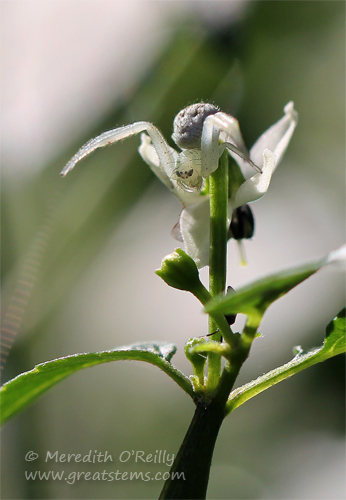 These little 8-eyed wonders do not spin webs like orbweavers do but instead are ambush hunters. They position themselves carefully on a flower then wait with the utmost patience for an unsuspecting bee or fly to land.
These little 8-eyed wonders do not spin webs like orbweavers do but instead are ambush hunters. They position themselves carefully on a flower then wait with the utmost patience for an unsuspecting bee or fly to land.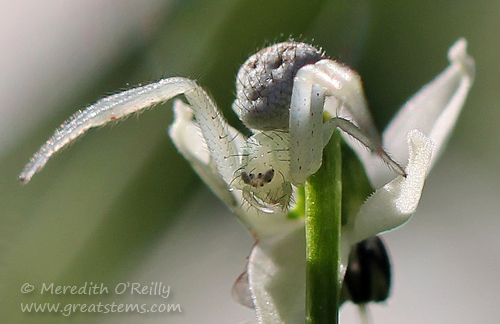
Typically they keep their longer front legs outstretched, ready to snap closed if their prey comes near. Those front legs are one reason these arachnids are commonly called crab spiders, but another is that the little spiders can scuttle backwards and sideways in the manner of a crab.
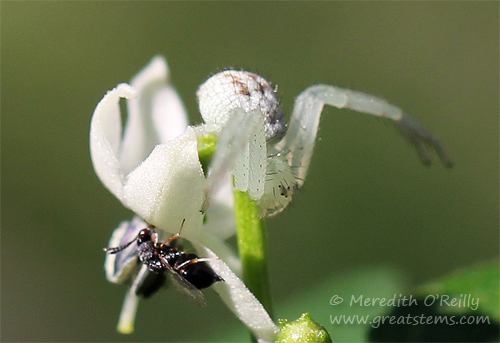 While this white crab spider (genus Mecaphesa) waited on the back of the flower, a little fly landed for some nectar, completely unaware of the danger it was in.
While this white crab spider (genus Mecaphesa) waited on the back of the flower, a little fly landed for some nectar, completely unaware of the danger it was in.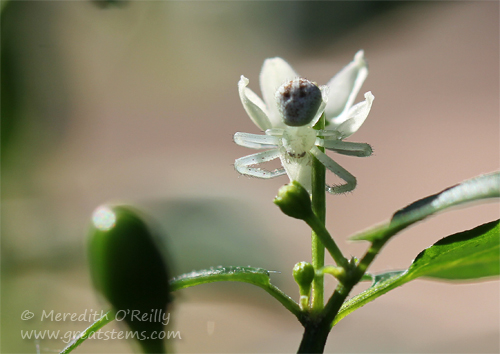 But I questioned the spider’s position on the back of the flower, thinking a more frontal position would be more strategic, until I saw the spider close its strong front legs in a flash. The fly did get away, but I consider it lucky.
But I questioned the spider’s position on the back of the flower, thinking a more frontal position would be more strategic, until I saw the spider close its strong front legs in a flash. The fly did get away, but I consider it lucky.
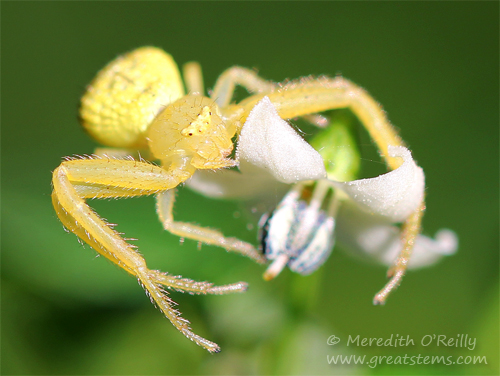
A few branches over on the same shrub, a yellow crab spider (also Mecaphesa genus) lurked on its own flower. Some crab spiders have the ability to change colors over a period of several days, either secreting or excreting yellow pigment to help it match the flower it is on. This spider would do well to change its color, or it should move over to a nearby Goldenrod flower, where it would blend in superbly.
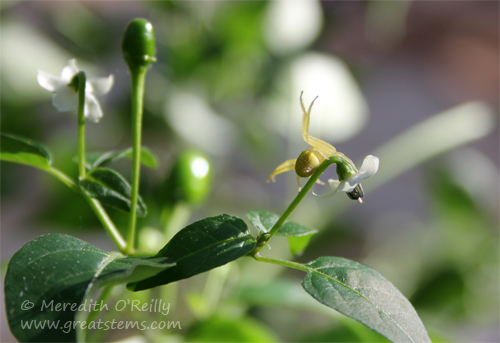
But I guess it’s content where it is for now. The Chile Pequin’s flowers are quite busy with pollinators, so I imagine the crab spiders are getting plenty to eat. Good luck, little spiders!
Edit: Thanks to Spider Joe for helping identifying these two spiders as Mecaphesa genus. Reading a little more, I see that two identification factors have to do with the size and position of the eyes and the hairiness of the spiders. Also, per Joe on Mecaphesa spiders, “Some of them can also turn red. They can also have not only changes in their overall color but major changes in the patterns of color on them, though those major changes typically occur at molt.” I so love to learn something new! Thanks, Joe!
I LOVE crab spiders. LOVE. Talk about cool creatures in super cool settings. Wow. Have actually apologized on my blog for posting SO MANY shots of SUPER cool crab spiders on flowers. You got some GREAT close ups of those little, intriguing creatures. Nice! =)
Thanks, Samantha. My friend Joe has been doing a study of crab spiders. I’ve got to start looking for more cool ones to get photos of!
I always learn something when I visit your blog, plus your photos are always awesome. I’ve seen similar spiders lurking about, but I didn’t know what they were doing. Now I’ll pay more attention.
Hi, Ally. I love those moments when something tiny catches your eye in the garden. Can you imagine how many lurking spiders we pass by every time we step outside?
Oh, wow! Thank you for these beautiful pictures and story! I’ll check out my pequins. I’m glad the fly got away this time, though. What a wimp I am! Really–you are quite amazing with your photography, information, and perceptions.
Thanks, Linda! I go back and forth between feeling sorry for the prey and being fascinated by the predator. But I guess that’s why I studied zoology in college — I really love all the creatures!
The shots of the white spider on the white flower are beautiful … and fascinating! You were very observant. I need to learn more about the types of spiders we have here. I see a lot of daddy longlegs and wolf spiders. The other day, a friend posted about someone finding a black widow in a package–they are native here, but rare to find indoors (thankfully). Fascinating information on these spiders–thank you for sharing!
Goodness — alarming to run across a black widow in a package. I’ve seen them elsewhere, but not yet in my own garden (nor in any packages so far). I guess I’m okay with that, though! I get so excited about every spider, I see, though. Even if I find a black widow, I’m sure I’ll take about a 1,000 pictures of it before redistributing far away from my house. FYI, daddy longlegs (harvestmen) aren’t actually spiders!
Now I know a lot more about crab spiders, plus I got to enjoy your fabulous photos of them. Thanks!
There is still so much to learn — thank goodness Spider Joe is a great resource for info.